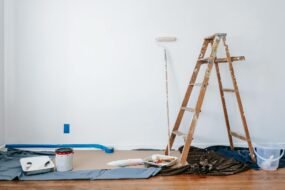
Home repairs can seem daunting, but many common issues can be fixed easily with a little know-how and the right tools. Whether it’s a leaky faucet, a hole in the wall, or a stuck window, taking on these repairs yourself can save money and give you a sense of accomplishment. This guide will walk you through some basic DIY home repairs that anyone can tackle.
1. Tools You’ll Need
Before diving into repairs, it’s essential to have a well-stocked toolbox. Here are some must-have tools for basic home repairs:
- Hammer and Nails: For hanging pictures, securing loose boards, and general repairs.
- Screwdrivers: Both flathead and Phillips head screwdrivers are necessary for assembling and disassembling furniture, fixing loose screws, and more.
- Pliers: Useful for gripping, bending, and cutting wires or nails.
- Adjustable Wrench: Ideal for tightening and loosening nuts and bolts.
- Utility Knife: For cutting materials like drywall, carpet, or packaging.
- Tape Measure: Essential for measuring spaces, furniture, and materials.
- Level: Ensures that everything you hang or install is perfectly straight.
- Drill: A cordless drill with various drill bits can make many tasks easier, such as installing shelves or curtain rods.
- Putty Knife: Used for spreading spackle or other compounds.
- Caulk Gun: For applying caulk around windows, bathtubs, and sinks to prevent leaks.
2. Fixing a Leaky Faucet
A dripping faucet can waste a significant amount of water over time. Fortunately, fixing it is usually a simple task:
- Turn Off the Water Supply: Locate the shut-off valves under the sink and turn them off.
- Disassemble the Faucet: Use a wrench to remove the faucet handle and then the cartridge or valve.
- Replace the O-Ring or Washer: Leaks are often caused by worn-out washers or O-rings. Replace these parts and reassemble the faucet.
- Turn the Water Back On: Once everything is back in place, turn the water supply back on and test the faucet.
3. Repairing a Hole in the Wall
Whether from a doorknob, furniture, or an accident, holes in drywall are common. Here’s how to fix them:
- Small Holes (Less than 1/2 inch): Use a putty knife to apply spackling paste over the hole. Smooth it out and let it dry. Sand it smooth, then paint over it to match the wall.
- Medium Holes (1/2 inch to 2 inches): Use a patch kit. Apply the patch over the hole, then cover with joint compound. Smooth, let dry, sand, and paint.
- Large Holes: Cut a square around the hole. Cut a new piece of drywall to fit and secure it with screws. Apply joint tape around the edges, cover with joint compound, smooth, let dry, sand, and paint.
4. Unclogging a Drain
A clogged drain in the sink, bathtub, or shower is a common issue. Here’s how to clear it:
- Use a Plunger: For sinks, partially fill the sink with water, then use a plunger to create suction and dislodge the clog.
- Remove the Trap: For kitchen sinks, place a bucket under the U-shaped pipe (trap) beneath the sink, then unscrew and clean out any debris.
- Use a Drain Snake: For tough clogs, insert a drain snake into the drain and twist it to break up or pull out the clog.
- Use Baking Soda and Vinegar: Pour a cup of baking soda followed by a cup of vinegar down the drain. Let it sit for 30 minutes, then flush with hot water.
5. Fixing a Running Toilet
A toilet that runs continuously wastes water and can be annoying. Here’s how to stop it:
- Check the Flapper: Open the toilet tank and check if the flapper is sealing properly. If it’s worn or not sealing, replace it.
- Adjust the Float: The float controls the water level in the tank. If it’s set too high, water will overflow into the overflow tube. Adjust it to the correct level.
- Check the Fill Tube: Ensure the fill tube is properly attached and directing water into the overflow tube.
- Replace the Fill Valve: If none of the above fixes work, the fill valve may be faulty. Replace it with a new one.
6. Repairing a Sticky or Squeaky Door
Doors that stick or squeak can be annoying but are easy to fix:
- Tighten the Hinges: Use a screwdriver to tighten any loose screws in the door hinges. This often fixes sticking issues.
- Lubricate the Hinges: Apply a few drops of oil or spray lubricant to the hinges to stop squeaking. Open and close the door several times to work the lubricant in.
- Check the Strike Plate: If the door isn’t latching properly, the strike plate (the metal piece on the door frame) may be misaligned. Loosen the screws, adjust the plate, and retighten.
7. Replacing a Light Fixture
Changing a light fixture can update the look of a room and improve lighting. Here’s how to do it:
- Turn Off the Power: Always turn off the power to the circuit at the breaker box before working with electrical components.
- Remove the Old Fixture: Unscrew the old fixture and disconnect the wires. Take note of how the wires are connected.
- Install the New Fixture: Connect the wires from the new fixture to the corresponding wires in the ceiling (usually black to black, white to white, and ground to ground). Secure the fixture to the ceiling.
- Turn the Power Back On: Once the fixture is installed, turn the power back on and test the light.
8. Sealing Drafty Windows and Doors
Drafty windows and doors can increase energy bills by letting cold air in during winter and cool air out during summer. Here’s how to seal them:
- Weatherstripping: Apply weatherstripping to the edges of doors and windows to create a seal when they’re closed.
- Caulking: Use a caulk gun to apply caulk around window frames and doorframes to fill gaps and cracks.
- Draft Stoppers: Place draft stoppers or rolled towels at the base of doors to prevent drafts.
9. Repairing a Loose Tile
Loose or cracked tiles can be a tripping hazard and detract from the look of your flooring or walls. Here’s how to fix them:
- Remove the Loose Tile: Carefully pry up the loose tile with a putty knife or chisel. Remove any old adhesive from the back of the tile and the surface it was attached to.
- Apply New Adhesive: Apply tile adhesive to the back of the tile and press it back into place. Ensure it’s level with the surrounding tiles.
- Regrout the Tile: Once the adhesive has dried, mix grout and apply it around the edges of the tile to fill in the gaps. Wipe away any excess grout with a damp sponge.
10. Fixing a Broken Cabinet Hinge
Loose or broken cabinet hinges can cause doors to hang unevenly or not close properly. Here’s how to fix them:
- Tighten the Screws: Use a screwdriver to tighten any loose screws in the hinge. If the screw holes are stripped, use longer screws or fill the holes with wooden toothpicks and glue before reinserting the screws.
- Replace the Hinge: If the hinge is damaged, unscrew it and replace it with a new one of the same size and style.
- Adjust the Hinges: Most modern cabinet hinges are adjustable. Use the adjustment screws to align the door correctly.
Conclusion
Taking on DIY home repairs can save you money, extend the life of your home’s components, and give you the satisfaction of fixing things yourself. With the right tools and a bit of know-how, you can handle many common household issues with ease. Start with these basic repairs, and as you gain confidence, you’ll be ready to tackle more complex projects.
Happy fixing!








